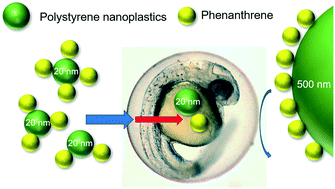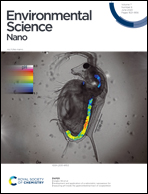Potentiation of polycyclic aromatic hydrocarbon uptake in zebrafish embryos by nanoplastics†
Abstract
The presence of microplastics in the environment and their potential effects on the health of organisms are a subject of great concern. However, with further weathering through UV radiation, mechanical force, and microbiological activity, most of these microplastics will degrade into nano-sized particles with exponentially higher specific surface areas compared to microplastics. Moreover, given that the hydrophobic surface of plastics adsorbs hydrophobic persistent organic pollutants (POPs), the possibility of nano-sized plastic particles potentiating POP sorption has been postulated. We developed a novel radiotracer-based method to investigate the sorption of a model POP, phenanthrene, onto the surface of two different-sized polystyrene nanoplastics (PS-NPs). Using radiotracer analysis, we compared the transport and uptake of 14C-phenanthrene in zebrafish embryos with two different plastic particle sizes. We also evaluated whether nano-sized plastics altered the toxicity of phenanthrene and the acute sub-lethal responses to phenanthrene in zebrafish embryos. Our results demonstrate that 20 nm PS-NPs have higher sorption capacity for phenanthrene due to increased total surface area per gravimetric mass. Moreover, we demonstrate increased phenanthrene across the chorion and into zebrafish embryos with nano-sized plastics when compared to sub-micron sized plastics. Co-exposure to nano-sized plastics and phenanthrene delayed hatching and induced higher EROD activity in zebrafish embryos when compared to sub-micron sized plastics. The results of our study demonstrate that nano-sized plastics facilitate the transport and uptake of hydrophobic organic pollutants and increase both their bioavailability and potential toxicity to aquatic organisms.

- This article is part of the themed collection: SDG14: Life Below Water – Marine Litter (Plastics and Pollution)


 Please wait while we load your content...
Please wait while we load your content...